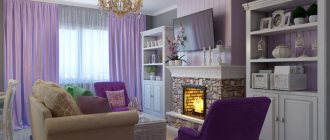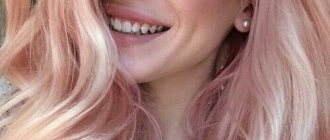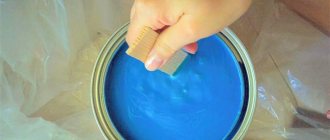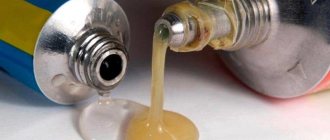General color characteristics
Beige (or beige) is usually called a light brown tone with an admixture of cream (yellowish) or grayish tint.
This is a neutral companion tone that can either play the role of a background for brighter colors, which will emphasize and reveal their depth, or become an additional emphasis on any details or objects.
The energy of the color is calm and stable, causing a feeling of comfort. Excellent perception due to its similarity to human skin tone.
A complete monopoly of beige color in the interior is not desirable so that the surfaces do not visually merge; other shades must be added to it.
The palette of beige shades is very wide, it contains tones with notes of sand, wheat, ivory, light caramel and light coffee, opal, cream, flesh.
Beige can also be combined with many colors, preferably brown or coffee tones, but combinations with colors such as light green, blue, wenge, lavender, blue, pink, olive and others are acceptable.
Table of mixing colors and their proportions to obtain brown color
The most popular shades (one common option for each is presented):
| Hue | Colors to mix | Proportions | ||
| Light brown | Green | Red | White | 100:5:5, 100:10:5 |
| Brown | Blue | Red | Yellow | 100:100:10 |
| Dark brown | Violet | Yellow | Black | 90:10:5 |
| Coffee color | Orange | Blue | Black | 100:50:10 |
| Chocolate | Dark green (herbal) | Orange | Red | 100:50:40 |
Thanks to this table, you can accurately calculate the ratios without the risk of making mistakes. Usually, 3 primary colors are enough to make a mixture of the desired shade only from them, or to synthesize orange/violet/green for subsequent mixing with red, blue or yellow. In some cases, black or white paints are indispensable. The brightness of the original tones is of great importance. If you choose the wrong ingredients, you won’t always be able to correct the color. It is necessary to add black in minimal portions, because this color is the most difficult to “overpower.” With the right skill, you can choose the components yourself and get the same classic or special rare shades. The brown base for subsequent adjustment is even synthesized from a combination of yellow, turquoise and pink/purple colors, which are secondary or completely absent in the spectrum.
"Recipe" beige
To get the desired color yourself, you need to prepare:
- multi-colored dyes - white, brown, gold, green and red;
- containers suitable for mixing - if you need to get a large volume of paints and varnishes;
- palette - if the amount of material is small (for example, for use in painting);
- artistic brushes for picking up colorant;
- canvas, paper or other covering, where the consistency of the resulting shade with the intended one will be checked.
Rules for mixing tones
There are several systems and models that determine the interaction and similarity of colors. The science of various aspects of the compatibility of shades and their use in art is called coloristics. One of its foundations is the color wheel, including intermediate colors. To synthesize different tones, 3 basic colors are used: red, yellow and blue. A special role is also given to achromatic colors - black and white. Mixing rules are built around these features. You need to mix watercolor, acrylic, gouache, oil, water-based and construction paints on a white palette - this is how the resulting shade is clearly visible. Instead, you can also use a white earthenware plate, and sometimes even plastic dishes, white cardboard or thick paper. There are 4 basic rules for color mixing:
- There are achromatic tones (white, gray, black) and colored (all others). In the second category, they differ in saturation, depth, brightness, lightness and hue.
- Mixing can be done mechanically (by stirring) and optically (by placing strokes on top of each other).
- When merging 2 of the main tones, you will get intermediate ones between them on the color wheel.
- When you mix 2 opposite colors on a circle, you get a composite that is unlike them.
Material selection
Gouache is most often used. It allows you to quickly and easily create the desired color scheme; the tones are beautiful and rich, and, if necessary, can be easily diluted with white.
Watercolor is also used to obtain beige, but this is a more labor-intensive process, since it is necessary to precisely maintain a balance between the amount of paint and water, so as not to obtain a faded, nondescript tone.
You can also use acrylic or water-dispersion or water-emulsion compositions as a basis.
Sometimes beige shades are obtained from a few pencil strokes or mixed colored plasticine balls. It all depends on the tasks and expectations of the master.
General information
Laws for mixing colors
Before starting design work, you should carefully study the rules of tinting in order to obtain the desired color, shade and tone for painting.
Paints can be divided into two types:
Achromatic - white, black and grayscale.- Chromatic - blue, yellow and red, as well as composite and even additional colors that are obtained by mixing such basic shades with each other.
For chromatic colors, tone, brightness, and also the ability to reflect or even absorb light rays will be important. When tinting paints, a 12-segment or even 24-segment color spectrum is used, in which the main chromatic colors are located at the vertices of an equilateral triangle, which is inscribed in a circle.
Between all the primary colors there are composite ones, which are obtained by mechanically mixing two nearby ones. When mixing compound and base colors, those that are near the color spectrum will receive additional halftones. This way you can create a color wheel of 12, 24 or even 48 colors.
| Base color | Composite |
| Yellow + red | Orange |
| Blue-+yellow | Green |
| Red + blue | violet |
How to get gray color and its shades
In order to prepare an achromatic gray color, you should mix white and black in different proportions, depending on what exact shade is required (in terms of intensity). To prepare a light gray tone, black paint should be gradually added to white. In order to get a concentrated dark gray tone, you should add white to black. New shades of gray should be created by mixing white with a base color and one component color that is in contrast to each other on the color spectrum.
| Proportions and colors | Resulting Color |
| Blue + orange + white, 1:1:2 | Grayish blue |
| Green + orange + white, 1:1:2 | Gray with a hint of yellow |
| Purple + lemon + white, 1:1:2 | Gray with a hint of beige |
An incredibly large range of gray undertones can be obtained by mixing primary, composite or additional colors. It is important to take as a basis the classic gray color, which is made from achromatic flowers.
| Proportions and colors | Result |
| Blue + main, 1:1 | Grayish pearlescent |
| Emerald + main, 1:1 | Grayish marble |
| Lemon + basic, 1:1 | Gray-yellow |
| Blue + white + main, 1:1:2 | Grayish blue |
| White + green + main, 1:1:2 | Green-gray |
Paint mixing technique
The easiest way to get a beige color is to dilute a small amount of brown paint with white.
The classic proportion of colors is 1:2 (4). You can add a small amount of yellow pigment to the base prepared according to this recipe.
Other methods:
- Mix yellow with white and pink. The main thing is not to overdo it with the latter, otherwise the consumption of white will increase significantly.
- Mix 6 parts white with 4 parts golden ocher. To make the resulting shade warmer, add a drop of red pigment; to “cool” the color, add a drop of green.
- Mix brown, yellow and a small amount of red and dilute with white to the desired depth.
- Mix blue, scarlet and yellow colors and dilute generously with white. You can add spice by adding a touch of gold to the composition. The resulting tone will be close to flesh tone.
The finished paint must be pre-tested on the base.
To do this, it is applied to the surface and left to dry. Observe changes in shade during the transition from a liquid to a dense state.
If necessary, you can darken the color with black or brown or dilute it with white to lighten it. The amount of dark dyes should be minimal so as not to give the tone a dirty gray effect.
Making shades of brown
A traditional palette is good, but its use is not always required, for example, when painting a wall in a hallway, a lighter tone would be more appropriate, but to give a picture realistic colors when depicting the earth, dark paint is usually used. Below are instructions on how to make brown darker or lighter:
- How to get dark brown color? Let's not reinvent the wheel and propose the most effective method - adding a black component. We recommend mixing in small drops, otherwise you risk ruining the resulting paint and will have to throw it away. After adding a small dose of black, mix thoroughly until the consistency is homogeneous, only then decide whether you need to darken it further.
- How to get light brown color? Here we will also follow the well-known path and propose a method for using white or white dyes. Adding brightening colors can be done more intensely than darkening ones. This is due to the fact that if you lighten the brown too much, you can always go back a couple of shades darker. The main white paint is white paint, in addition to it you can use yellow - which will give an ocher tint, red - will give shades of rust, and blue will make it deeper and more contrasting.
For art lovers, together with Olga Bazanova, we have prepared a video lesson on mixing brown from other colors:
"Plasticine beige"
Plasticine products also require the use of a wide variety of colors. Beige is no exception.
You can get it by combining pieces of white, red (or pink), yellow and orange (you can take coral) material.
The amount of white should be 85-90%, the rest is a mixture of all other shades mixed in equal proportions.
You will have to spend a lot of time to mix the plasticine thoroughly enough - it should become completely homogeneous, without inclusions, veins, or unmixed multi-colored stripes.
It will become easier to work if you warm up the plasticine a little in a bag under warm water - it will become much more pliable and softer.
Pros and cons of mixing brown
As strange as it may sound, making your own brown paint is not always the best idea. Let's look at when it is profitable to mix, and when it is better to buy ready-made dye:
- You paint with acrylic paints on canvas - here you can make brown and its shades in any quantities and portions of colors;
- You are making repairs and there are excess paints left from which you can get brown for use in the intended design;
- You do whatever you want, but the color palette presented in stores doesn’t contain what you need;
- If the design of the room includes brown walls, then you should not buy other colors to mix them; there are enough brown paints in hardware stores to choose the right one;
- If you dye your hair, you should not mix different components, even of the same shade, unless this is provided in the instructions;
- If you are not sure in advance that you will use brown.
Shades of brown











